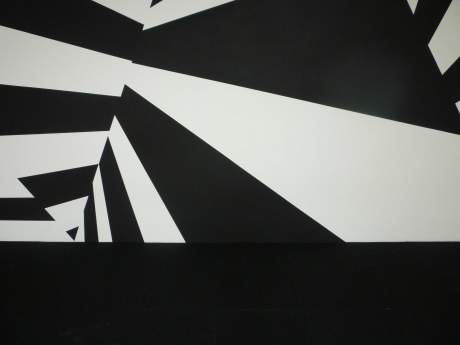
Jonathan Schipper, The Slow Inevitable Death of American Muscle, at Ballroom
Marfa Sidelights, Chinati’s 25th Anniversary Weekend
This year’s pilgrimage to Marfa on the occasion of Chinati’s 25th Anniversary Weekend was well worth the effort, not only for the main events, but for the many other surprises, some in unconventional venues like Tableaux Parisiens, an exhibition of art from and about Paris in an old church called The Do Right Hall, Patrick Keesey at the Marfa Country Clinic, Valerie Arber at the Thunderbird Lodge, and Charles Mary Kubricht at The Marfa Book Company. Because Marfa is still to some extent a tiny, geographically isolated ranch town it serves as an amazing counterpoint to the global discourse. The town of Marfa itself, beyond Donald Judd’s legacy, has become a lure for dislocated malcontents (meant in the most positive, inclusive sense – aren’t we all?), functioning as a museum of small town USA, as well as an experimental canvas for future communities.

Valerie Arber (hand painted paper on aluminum) at the Thunderbird Lounge
Jonathan Schipper’s sculpture, The Slow Inevitable Death of American Muscle, steals the AutoBody show at Ballroom with its nearly classical agonistic form. In the back courtyard two ‘driver-less’ muscle cars face-off along a track, being imperceptibly, infinitesimally ground together in a slow-motion crash, with the cranks and gears behind this wizardry visibly enshrined alongside. Since the cars move about half an inch per day, the entire crash will last the four months of the exhibition. The quintessential American spectacle of self-destruction, masquerading as one against the other, is here vivisected for our pleasurable, seemingly endless, contemplation. Paul Virilio, critic of the art of technology, might have used this work to illustrate his idea that disaster is implicit in the inventions of science. Enormous tensions between accident and intention, commonly regarded as opposites,and between intellectual knowledge and real-time perception are at the core of the piece. A live video feed of the work played on a monitor inside the ballroom space and a ballroom employee told me that this will also be posted online, so that we may watch this anti-spectacle via the internet. Probably the end result will have the cars rearing-up like two stallions locked in combat.

Jonathan Dankenbring sculptures at Exhibitions 2D
Jonathan Dankenbring’s sculptures at Exhibitions 2D also have an oddly classical feel, as if we were traveling back in time, discovering the slow, mute prototypes of today’s fast and noisy culture. He has cast and carved ipods, ipads, iphones, sony walkmans, that we may feel and ponder them, divorced completely from their use value. Instead of using the devices as vehicles to transport ourselves into other dimensions, we are compelled to stay in our bodies here-and-now while handling their replicas, noting weight, balance, texture, and subtle visual qualities. Concrete is not resin is not hematite is not jade…. If we are frequently confused, living the merging of digital and material worlds, imagining we can replicate by hitting “control c”, Dankenbring’s work brings us home to an awkward and beautiful gap, in which neither material reality, nor our mastery can be taken for granted.

Patrick Keesey ink drawing in Saccade at Marfa Country Clinic
Patrick Keesey shows ink drawings in an exhibition at the Marfa Country Clinic entitled Saccade, meaning a rapid intermittent eye movement which occurs when the eyes fix on one point after another in the visual field. Discrete, jerky jags, loops, hooks and scrawls of colored ink attempt to render Keesey’s process of looking rather than represent the object’s appearance, somewhat in the manner of a blind contour drawing. The resulting delicate drawings are reminiscent of web-like versions of abstract expressionist Philip Guston or Joan Mitchell, though the accompanying essay draws on Lacanian psychoanalytic theory while the gallery statement emphasizes the scientific use of saccadic movement studies in diagnosing neurological disorders. Both are interesting amplifications rather than exhaustive keys to the mysterious code of Keesey’s work.
Chinati’s artist-in-residence Justin Almquist presents a large body of witty and fluent drawings pinned to the walls, as well as papier-mâché reliefs and works on plastic. There is the sense that a border-town desert aesthetic has happily made its mark on the hats cum skull masks made out of Big Bend-area newspapers, the abstracted gut or rattlesnake forms of the reliefs, and in the art brut concoctions of dirt and glue on scavenged black plastic. At the Thunderbird, Valerie Arber’s glowing prismatic serape-like abstractions have taken wing, freeing themselves from frames and the second dimension. Meticulously hand-painted paper is mounted on shaped and bent aluminum supports, creating a fusion of minimalism and mexicanism that also seems utterly Marfan.

Charles Mary Kubricht at The Marfa Book Company
